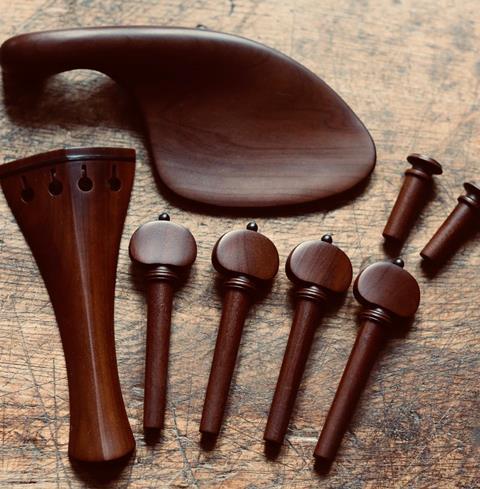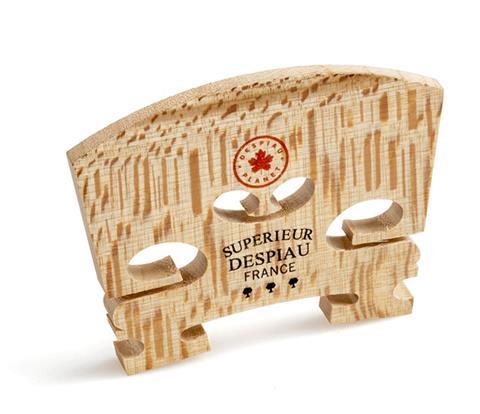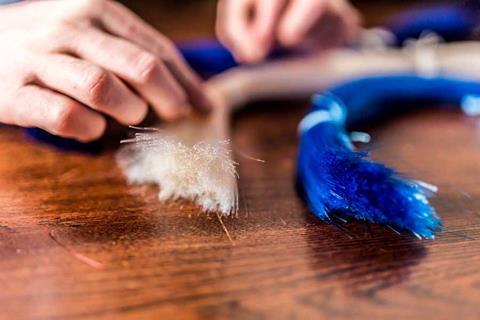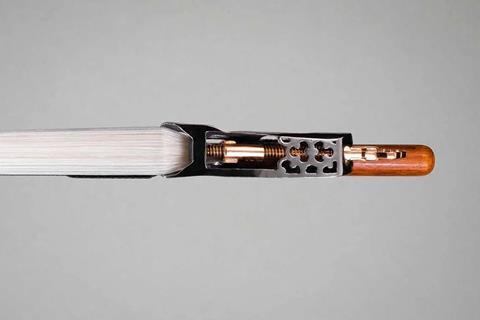Peter Somerford explores the growing market for ethical, sustainable accessories for string players and luthiers, from hardwood and ivory alternatives to a vegan violin made with steamed pear and wild berries

There are so many ways today for people to do their bit for the planet, whether it’s flying less frequently, avoiding single-use plastics, switching to greener energy, or striving to repair, reuse or recycle. But when string players think about the environment and sustainability, do they consider the tools of their trade? Regular readers of The Strad will know of the threats to some of the exotic hardwoods traditionally used in instrument fittings and bows. Pernambuco and rosewood are both subject to regulation by the Convention on International Trade in Endangered Species of Wild Fauna and Flora (CITES). Ebony from Madagascar is also CITES-protected, and overharvesting and illegal logging may lead to other ebony species facing restrictions in the future.
Luthiers and accessories makers have responded with a suite of alternative, more sustainable materials, from common woods like beech and spruce that have been modified to increase their density and hardness, to compressed paper and natural fibre-based composites. As for endangered fauna, there are CITES trade bans on ivory and on tortoiseshell, once ubiquitous on the finest bows. For vegan players and those concerned with animal welfare, there are synthetic or metal alternatives to ivory or mastodon ivory bow tips, faux-leather substitutes for leather or lizard-skin thumb grips, and synthetic bow hair can be used instead of horsehair.
‘If a musician asks about fingerboards, it would help if the maker could offer one in an alternative material’ – Olivier Pérot
With any switch from a traditional material, there can be concerns about having to make compromises. Will it sound or feel as good? Will it be as durable? Will it look different? And how much more will it cost? Accessories manufacturers are sensitive to such concerns, and are pushing to develop sustainable products that satisfy players’ demands for tonal quality, responsiveness, handling and reliability, while not straying too far from aesthetic conventions. The technologies behind materials such as modified or densified woods are, however, not yet at the production scale to enable these products to compete on price with a wood like ebony. Another issue is that some alternative materials carry their own environmental cost. So someone choosing a carbon-fibre bow over a pernambuco one may not be aware how energy-intensive carbon fibre is to produce. Similarly, replacing natural materials such as horsehair, which is a by-product of the slaughter industry, with synthetic substitutes can contribute to more non-biodegradable material impacting on the planet.
Such dilemmas notwithstanding, it is important that more alternative, innovative and sustainable products are made available to musicians, but also that players, makers, dealers and suppliers are aware of the issues facing species used in the trade. ‘Education is the most important thing we can do right now,’ says Montreal-based luthier Olivier Pérot, one of the founders of the International Alliance of Violin and Bow Makers for Endangered Species. ‘We should be going into conservatoires and violin making schools to explain about the woods and animals we use and how we can protect them. But at the same time, when luthiers learn about the challenges facing endangered species, they could put pressure on their wood dealer or fittings supplier.’ Musicians can be agents for change too, he suggests. ‘Players could ask their violin maker or bow maker where the wood they use has come from, and if it’s from a sustainable source. If a musician knows about the problems facing ebony, for example, and goes into a violin shop and asks the maker about the fingerboards they use, it would help that maker if they could offer a fingerboard in an alternative material. Everybody has to do their bit, and everyone has to understand the goal. If we just wait for the customer, dealer, or maker to act, we won’t make progress.’
How are accessories manufacturers and makers measuring up to the goals of sustainability? Let’s explore some of the latest products and developments that are helping to widen the choices available to string players.
Instrument fittings

Fingerboards and tailpieces, especially for larger instruments like cellos and basses, place the most demands on sourcing high-quality ebony. But several sustainable ebony alternatives have begun to establish a reputation in the market, and this is an area that is seeing some of the most interesting technological innovations. Swiss start-up Swiss Wood Solutions (SWS) has been making its Sonowood fingerboard blanks from modied maple, spruce and walnut, carefully compressing and heating the wood in a thermo-hydro-mechanical process until it matches or exceeds tropical hardwoods in density and hardness. SWS recently introduced a black beech version, Sonowood Black, that ful ls the company’s ambition to produce a true ebony substitute that’s a match for ebony in acoustic properties, as well as physically and visually.
Christian Lehringer, SWS’s chief product officer, says: ‘This year we’re working on upscaling production of Sonowood Black to make larger quantities as well as larger fingerboard sizes, up to cello.’ Beech was chosen for its abundance, affordability and favourable mechanical properties, as well as its suitability for impregnating with liquid. ‘We impregnate the wood with a natural colouring before the modifcation process,’ explains Lehringer. ‘It’s important to us not to introduce any artifcial pigments that would reduce the product’s biodegradability. We want to keep the wood as natural as possible.’
Although he recognises that Sonowood Black is more expensive than ebony, Lehringer says that upscaling established production processes will help drive down the price, and that the price differential will become smaller as the cost of raw ebony increases. ‘There is only one direction for ebony prices in the next five or ten years, and that is up. The quality and quantities that are available today won’t be there for the same price in the future.’ And if ebony trade restrictions do come into force, could we see a whole new generation of fingerboards and tailpieces made from densifed wood? ‘It’s a manufacturing process that could be used widely, although you need detailed expert know-how to get excellent results: we have at least 25 parameters we must reach to achieve the desired qualities. But upscaling production won’t be a problem when the market demands it.’
’Densified wood could be used widely, though you need expert know-how to get excellent results’ - Christian Lehringer
German fittings company Berdani has developed an ebony alternative called Dark Paper, a composite of recycled paper and natural resin that is 100 per cent biodegradable. It is made by soaking paper with resin before compressing it under high pressure. Berdani’s range of Dark Paper products includes chin rests, pegs, end-buttons, nuts and saddles, as well as tailpieces and fingerboards. The company also others fittings made from a rosewood substitute in the form of densifed boxwood.

Other ebony substitutes, while contributing to the wider goal of conserving tropical forests, arguably have fewer eco credentials because they incorporate synthetic and not just all-natural, biodegradable materials. At the more affordable end of the market is Flaxwood, a natural fibre-reinforced thermoplastic. Developed in Finland by a company that uses it to make electric guitars, the material has also been used for fingerboards. However, for a material that is virtually indistinguishable from ebony in its look and feel, Corene, from Swiss firm Néo-Ebène, is a premium composite made from paper fibres and a phenolic resin binder. If a black-brown ebony colour is not a deal-breaker for players, then the choice of fittings widens to include non-endangered woods such as boxwood and native North American species like mountain mahogany and Southern live oak. All three of these are used for fittings by luthiers Hellweg & Cloutier in Sarasota, Florida.
It is not just exotic hardwoods that have suffered from overharvesting. The sustainability of high-quality maple from countries such as Bosnia and Romania has also become a concern, and has led one bridge manufacturer, Despiau Chevalets, to reassess its sourcing policy and selection criteria. ‘In the past,’ says the company’s CEO Nicolas Despiau, ‘we rejected excellent “sounding” trees if they had small visual particularities or distinctive features, and so the wood supplier would have to go back to the forest and cut more trees. Now, every time we go into the forest we can find what we need, because we can work with those trees with particularities. It’s a win-win for the forester and the bridge maker.’ The company’s Despiau Planet line of bridges, which launched in 2020, uses maple from trees that have lived through historic climatic extremes, resulting in the aforementioned aesthetic variations in the wood. ‘A bridge is dedicated to the sound,’ emphasises Despiau. ‘It’s not important for it to look especially beautiful. Despiau Planet bridges have the same sound characteristics as our premium Despiau 3-Tree bridges, so for musicians it’s an easy switch to make because they will not be compromising on the sound.’ He notes that despite increasing sales, there is still some wariness in the trade about the notion of visual particularities on bridges, and he says: ‘Some makers don’t understand the situation because they are too far away from the forests. We are at the frontline of the forest and we can see how so many trees are wasted just to find an exceptional one.’ In a further sign of the company’s commitment to its natural resources, a small proportion of each purchase of a Despiau Planet bridge goes to the International Alliance of Violin and Bow Makers for Endangered Species to support its advocacy work and involvement in conservation projects.

Bow and bow hair
For many players and bow makers, a fine bow of pernambuco has no equal. But this most prized of woods is also one of the most endangered, with its native habitat in Brazil, the coastal Mata Atlântica rainforest, reduced to only seven per cent of its original size. CITES restricted international trade in pernambuco in 2007, but there are no export controls on finished products, including bows produced in Brazil, and illegal logging and trafficking continue to be a threat (see On the Beat, April 2022). While bow makers have worked to support replanting projects through the International Pernambuco Conservation Initiative and other programmes, there have also been attempts to find an alternative wood that can prove a match for pernambuco’s combination of sonic qualities, strength, density and flexibility. French bow maker Gilles Nehr makes a striking case for giraffe thorn or camel thorn acacia (Vachellia erioloba) with his innovative, ‘self-rehairing’ Tête-Bêche bow, which also features titanium for the tip and frog. A native tree of southern Africa, giraffe thorn is commercially available as bow blanks, but is a naturally much lighter-coloured wood than pernambuco, although Nehr has been able to darken it so it’s closer in appearance to pernambuco. Baroque bows often use snakewood or ironwood, but Dutch cellist Coen Engelhard, who is based in the south of France, uses local acacia wood to make bows for both Baroque and classical instruments.

With the pressures on pernambuco supply, carbon-fibre bows have become extremely popular. But for all the durability, strength and consistency of this high-tech material, producing carbon fibre, which is derived from petroleum, can be a wasteful and energy-intensive process. However, with the rising cost of fuel and energy, an increasing demand for more sustainable carbon fibre from major industries including the automotive and aerospace sectors is driving research into bio-based carbon fibres, as well as more advanced recycling techniques to enable wider reuse of the material. Sustainability becomes even more of an issue if cheap mass-produced synthetic bows, made of glass fibre or epoxy resin and carbon fibre, are simply discarded and replaced instead of being rehaired. This is one reason why some proponents of synthetic bow hair, which can last longer than horsehair, advocate its use for student bows. Cécile Limon, co-director of Cardiff Violins, the UK distributor for Coruss synthetic bow hair, says: ‘With very cheap bows, the kind that children use, we might suggest rehairing with Coruss, because then they could get a few years out of the hair.’
Coruss was developed by the Toulouse Chamber Orchestra in partnership with the French Institute of Textiles and Clothing, primarily to be a more reliable and stretch-resistant alternative to horsehair when moving between different humidity levels on tour. But the synthetic material has unsurprisingly become popular with vegans, who want to avoid any connection with the slaughter industry. ‘The majority of people who ask about Coruss are vegan, because that is their primary concern,’ says Limon. ‘But Coruss is also popular with people who travel a lot, who play outdoors, who play in pubs. People also want to save money on hair, and Coruss lasts three times as long as horsehair.’ Because it doesn’t have barbs like natural horsehair, Coruss needs a different approach to rosining. Pops bass rosin has been recommended as a base coat before applying rosin as usual, but the Coruss makers have also developed a rosin specifically for their synthetic hair.
Read: Making Matters: Making fingerboards green
Read: Feeling powerless as a musician in the face of the climate crisis? 6 ways to take positive action

Rosin and glue
Sticking with rosins, Andrew Baker, the founder and director of premium Australian brand Leatherwood Bespoke Rosin, has created an environmentally friendly rosin that’s also totally vegan. Containing only pine resins and a plant-based wax instead of beeswax, ecoRosin comes with an organic hemp wrap and is packaged in recycled cardboard. ‘We wanted to create a complete product for our vegan clients,’ says Baker, ‘but we also wanted to get away from plastics. Most rosins use plastic or another synthetic material as the wrap. But using hemp and also recycled and recyclable cardboard means that all the ingredients and materials are biodegradable.’ The rosin is presently available for violin, viola and cello; for the softer, stickier bass rosin, Baker says he is working on developing a more eco-friendly, biodegradable substitute for the silicone cup that Leatherwood usually employs. The company’s environmental commitment is also evident in its pledge to offset estimated CO2 emissions from its production of ecoRosin, and in its goal of becoming a certified Australian carbon-neutral business.
’We wanted to create a product for our vegan clients, but also to get away from plastics’ - Andrew Baker
For vegan players, the hide glue used in stringed instruments has been an inescapable ethical compromise, but early in 2022 a violin made international headlines as the first to be certified by the Vegan Society. Its maker, Padraig ó Dubhlaoidh, who is based in Malvern, UK, used a range of plant-based and natural ingredients, including steamed pear which is dyed black and poplar for the purfling, wild berries, and a glue based on pure local spring water. The luthier makes vegan and non-vegan instruments in separate workshops, using separate equipment and materials, to prevent any cross-contamination.

As some of the major drivers of innovation in a market that is sometimes slow to embrace changes to traditional materials and aesthetics, accessories makers are well placed to respond to players’ ethical preferences and sustainability concerns. As Baker says, ‘If there’s going to be a greater suite of products available to makers and players over the next few years that fit this eco brief, that shows that the industry is trying to create a better world, I think it will be well received.’








































No comments yet